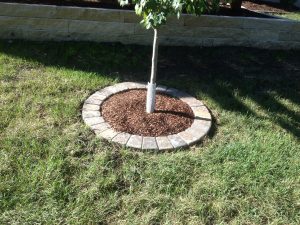Recently I was at the Northwest Flower and Garden show and spoke to a gardener who was excited about some new information from his garden club meeting. Their speaker was a dowser – who promotes dowse gardening.

Now this was a new concept for me. I’ve heard of dowsing, of course, in the context of finding underground water. But dowse gardening?
Fortunately, my gardening friend shared his handout with me. I did a little Internet sleuthing and found the author, whose goal was to combine her two interests: dowsing and gardening. In a 2003 column, she stated “My main focus is ways of using subtle energy to get good crops or gardens.”
For me, this was an immediate red flag. It’s very much like the author’s motivation in The Sound of Music and Plants. Searching for a topic for an undergraduate research topic, she asked “What in the world can I do with music and plants?” Trying to force two unrelated subjects together without preliminary data to suggest the pairing is not a logical approach to scientific inquiry.
Anyway. Back to dowse gardening. It would take me weeks to dissect all of the claims made in the handout. In brief, the presentation explains how to find energy, how to receive and broadcast energy, and how to use “subtle energy” to grow healthier plants and control pests.

Unfortunately, the specifics on exactly how this happens were not given. But attendees were advised to create circle gardens (they are energy outgoing), to use earth energies to determine where and where not to grow plants, and to use prayers and crystals to improve seed sprouting. At least in this last case there were data:
“Prayers over seeds -30% increase in sprouting and production – energy! Next step – crystals pointed at sprouting seeds, 50% increase in sprouting and production – energy!”
And finally, there were all kinds of products that were recommended, including
- French coils for “inducing beneficial energies in trees and larger perennials”
- Energized water made by a process “that can transform our banal tap water back to its natural potent state as the elixir of life”
- Sonic Bloom – an “organic fertilizer applied with sound”
- Slim Spurling’s Light Life Tools which “support the work of environmental clearing, air pollution clearing, energy balancing, water improvement, alternative agriculture methods, insect control without sprays, beneficial insect enhancement, alternative health methods, personal self-care, computer radiation reduction, EMF pollution reduction, personal life improvement as well as business improvement”
- Intrinsic Data Field Analyzer – “a consciousness interactive instrument that has been used experimentally to detect and balance the IDFs of plants, animals, minerals, and virtually all animate and inanimate objects”

As a scientist, it’s easy for me to discount all of this as silliness. But the fact remains that many people, including gardeners, long for mystical approaches to life. And unfortunately there are always going to be hucksters waiting to take advantage of that longing.
The photo of the tree has more problems than just being lonely. The mulch that’s been installed is up against the trunk of the tree which, over time, will encourage bark rot or other fungal diseases. Areas of a tree that are covered with bark were not meant to be covered with soil or other moisture retentive materials, such as mulch.
It is best to leave a clear mulch-free ring around the tree’s root crown. The set back should be 6″ to ensure that the mulch does not creep towards to root crown.
Very good article. Loved it~ !
Groooooooaaaaannnnnnn!!!
Why can’t they just read How Plants Work and save themselves a lot of time, money, and silliness?
Sadly reading books seems to be a lost passion for too many people. More exciting to get it on the internet.
And if someone typed or pasted it on the internet then it must be true!
Findhorn! Here in the US!
I needed a laugh tonight but all I got out was a snort. Sad to think people will still pay for snake oil
Points off for the visual strawman argument. Your circle garden example is merely a tree ring. Search for “circle garden energy” and you can find all sorts of gardens, some beautiful, others prosaic. But the basic design is that of plants growing in a set of circular beds, not a plant stuck in the middle of a circle.
Tell you what – provide me with some scientific references for “circle garden energy” and I’ll be happy to read them and revise my post if necessary.
Linda, you know what a straw man argument is. In this case you presented a simplified example that you knew was not what the speaker referred to. Skip the word “energy” and just google circle garden. There is only one photo that shows a tree ring. And since that links back to the photo in this blog, you can’t use it because that would be a circular argument.
As to scientific references to “circle garden energy” (which I googled to see photo examples of what the speaker was referring to) there are none because, as your post points out, it has nothing to do with science. There are no scientific references to circle gardens, period. If you post a photo of a parking lot island with three Salvias, five Rudbeckias, and a Perovskia and call it an English Cottage Garden, there will be no scientific references to be found for “English Cottage Gardens” if someone calls you on that.
I never said there was any scientific merit to any of the claims in the speaker’s outline. I merely dinged you on the visual logical fallacy you included in your piece.
A couple of things to consider, Chris. One: I have no idea what the speaker was referring to. There are no photos on the handout nor on the website. The important thing appears to be the shape and how it affects energy. How do we know that she doesn’t consider a tree ring to be a circle garden? I imagine she would recommend a “tree circle” rather than a “tree square.”
Two: Every decent looking circle garden photo I could find in an image search was not licensed for reuse. So I chose to use the sad tree rather than having unbroken text which is even worse than the tree ring.
I have to admit, the tree circle was amusing. The best example of a circle garden, and by best I mean most absurd, was a photo titled “artificial grass circle garden”. The circular lawn overlapped hardscape circles and the whole was surrounded by semi-tropical plants. I assumed it was in southern California where artificial turf makes some sense. Turns out it was installed in Ireland! Not what I think of when I hear the phrase ‘a bit of the auld sod.’ Sadly, I doubt the photo was licensed for reuse.
Excellent research. Sorry we can’t share in what you found 🙂
Have been beginning to think that some of your public are even more gullible than our own in the UK. This one takes the biscuit! So many pieces of nonsense in one product claim.
“But the fact remains that many people, including gardeners, long for mystical approaches to life.” Hey, I’ll ‘fess up to liking a little of the mystical in my life…but truth is far more awesome and mind-blowing and dare I say ‘magical’ than any woo-woo made-up pseudo-science. Linda, I look forward to you speaking here in Canada; I have been recommending this blog, the fb page, and your books to anyone who’ll listen.
Thanks, Tiana, and I look forward to seeing you in Canada!
Fairy gardens, rock energy, and fairy circles aside, I have actually seen well drillers dowsing with metal rods to find veins of groundwater here in Pennsylvania. I couldn’t believe it was an actual practice used by professionals and not just a television joke!